Lal R., Shukla M.K. Principles of Soil Physics
Подождите немного. Документ загружается.

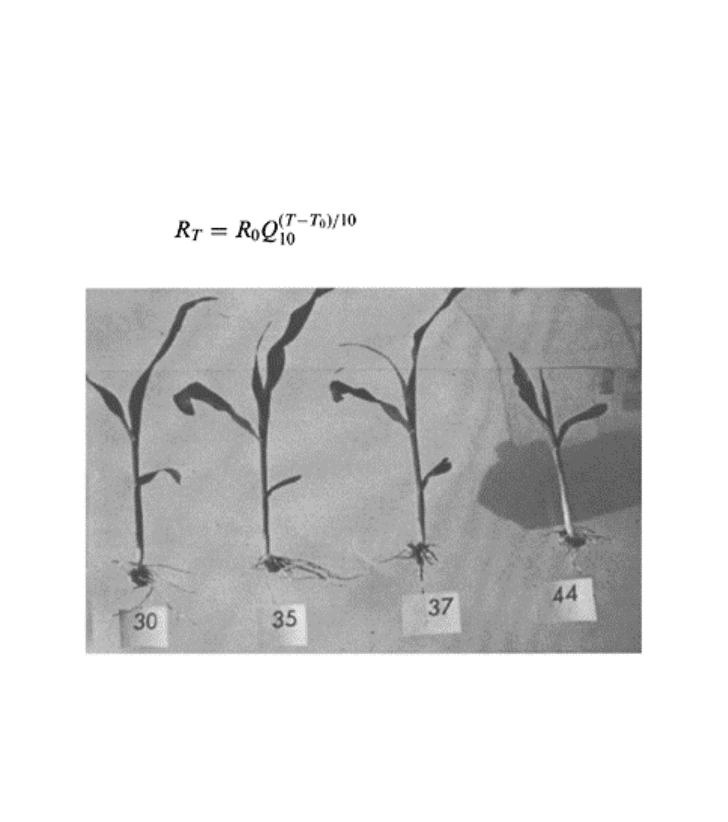
germinate nor plants have a normal growth because it affects root and shoot growth and
availability of water and nutrients (Fig. 17.1). The optimum range of soil temperature for
plant growth is between 20 and 30°C. The rate of plant growth declines drastically when
temperature is less than 20°C (suboptimal) and above 35°C (supraoptimal) (Figs. 11.2–11
A). Further, all soil processes are temperature dependent. Consequently, the thermal
regime of soil strongly influences the edaphic environment. The release of soil nutrients
for root uptake is also dependent upon soil temperature regime. The biological processes
(such as respiration by plants) are temperature dependent. Respiration rate (R
T
) at a
temperature (T) is expressed as follows:
(17.9)
FIGURE 17.2 Corn seedling growth
in relation to constant soil temperature
maintained from 30 to 44° C in the
root zone. (From Lal, 1972,
greenhouse experiments.)
Principles of soil physics 484
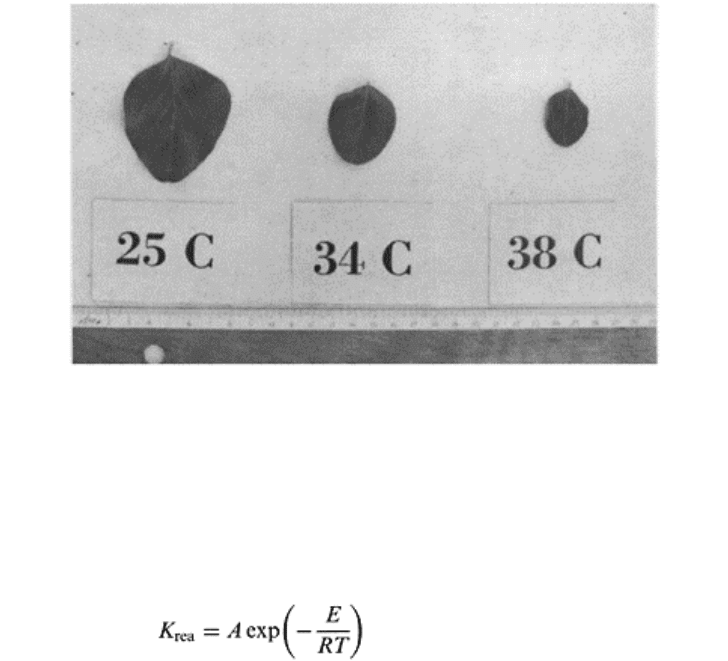
FIGURE 17.3 Soybean leaflets of
seedlings grown at constant soil
temperature of 25 to 38°C. (From Lal,
1972, greenhouse experiments.)
where R
0
is rate at reference temperature T
0
, Q
10
is the factor which relates respiration to
each 10°C change in temperature. The reaction rate (K
rea
) in soil is mostly described by
the Arrhenius equation as follows:
(17.10)
Soil temperature and heat flow in soil 485
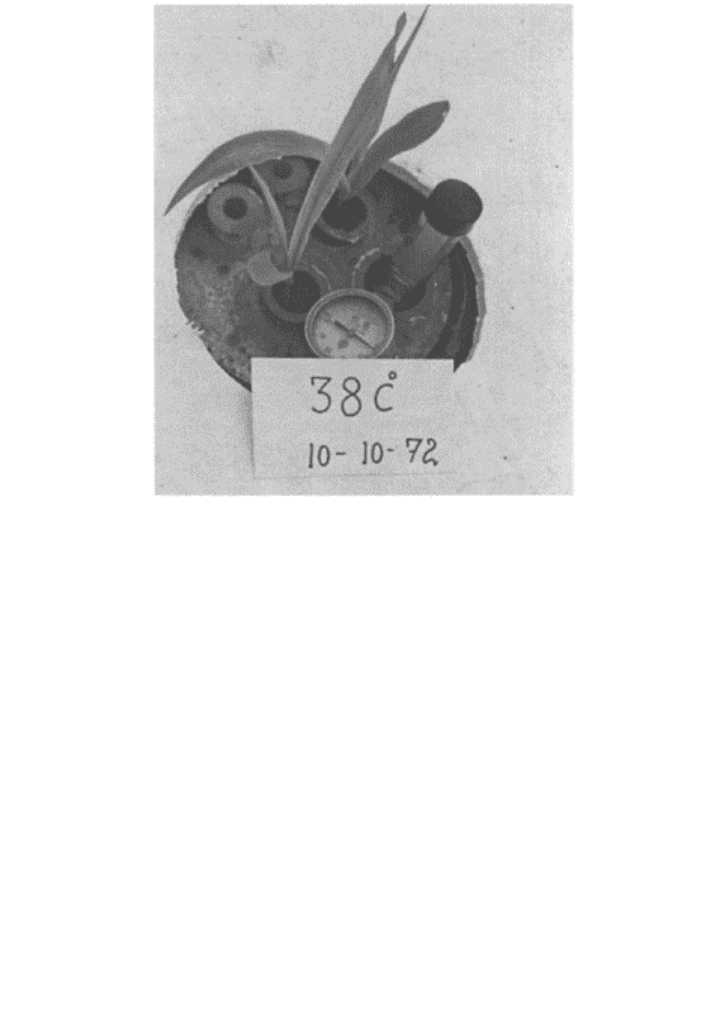
FIGURE 17.4 Chloratic symptoms of
nutrient imbalance in corn seedlings
grown at constant soil temperature of
38°C. (From Lal, 1972, greenhouse
experiments.)
where A is the preexpopnetial factor, E is activation energy (J), R is gas constant (8.314
Jmol
−1
K
−1
), and T is absolute temperature. A plot of logK
rea
vs. 1/T provides the values of
empirical constants E (as the slope) and A (as the intercept).
Soil-water movement, soil-water availability, evaporation, and aeration are also
governed by soil temperature. Heat stored near the soil surface has a strong influence on
evaporation from soil. A drier soil warms up relatively more quickly and cools down
faster than wetter soil because heat capacity of water is several times more than that of
soil. Soil temperature also influences the properties of water, such as surface tension, and
to a lesser degree, viscosity and density (Table 17.3). Hence, soil-water characteristic
curves and hydraulic conductivity functions are also temperature dependent. Bouyoucus
(1915) was among the first to observe water movement caused by the soil temperature
gradient. He imposed temperature gradients across soil columns, which were at different
water contents and contained different soil materials. He found that the difference in
water between two halves of column was dependent on both soil material and initial
temperature.
Principles of soil physics 486

Soil temperature varies as a result of radiant, thermal, and latent heat energy exchange
processes, which take place primarily through the soil
TABLE 17.3 Density and Viscosity of Water at
Various Temperatures
Temperature (°C) Density (g cm
−3
) Viscosity (cp)
0 0.99987 1.787
3.98 1.00 1.568
5 0.9999 1.519
10 0.9997 1.307
20 0.9982 1.002
30 0.9957 0.7975
50 0.988 0.5468
80 0.971 0.3547
100 0.9584 0.2818
Source: Adapted from Handbook of Chemistry and Physics, 1988–89.
surface. Soil characteristics, which govern temperature regime, include bulk density,
degree of wetness, soil heat capacity, and thermal sources and sinks present in soil
matrix.
17.8 SOIL TEMPERATURE REGIMES
Soil temperature continuously varies in response to the changing meteorological regimes
acting upon the soil atmosphere interface. The meteorological regimes are characterized
by periodic succession of days and nights and winters and summers. Daytime heating is
by short-wave radiation from the sun and sky, whereas nighttime cooling is from long-
wave radiation emitted by soil. The temperature regimes of soil surface have two cyclical
periods, namely diurnal and annual cycles.
17.8.1 The Diurnal Cycle
The variations in soil temperature owing to daytime heating and night-time cooling are
known as diurnal variations. In the morning before sunrise, the minimum temperature of
soil is the lowest at surface and increases with increase in depth. Similarly, the
temperature continues to rise in the lower layers even after the top layer starts to cool
down. However, the amplitude of the diurnal wave continues to decrease with soil depth
(Fig. 17.5). The amplitude of the surface temperature fluctuation is the range from
maximum or minimum to the average temperature (Fig. 17.5).
Soil temperature and heat flow in soil 487
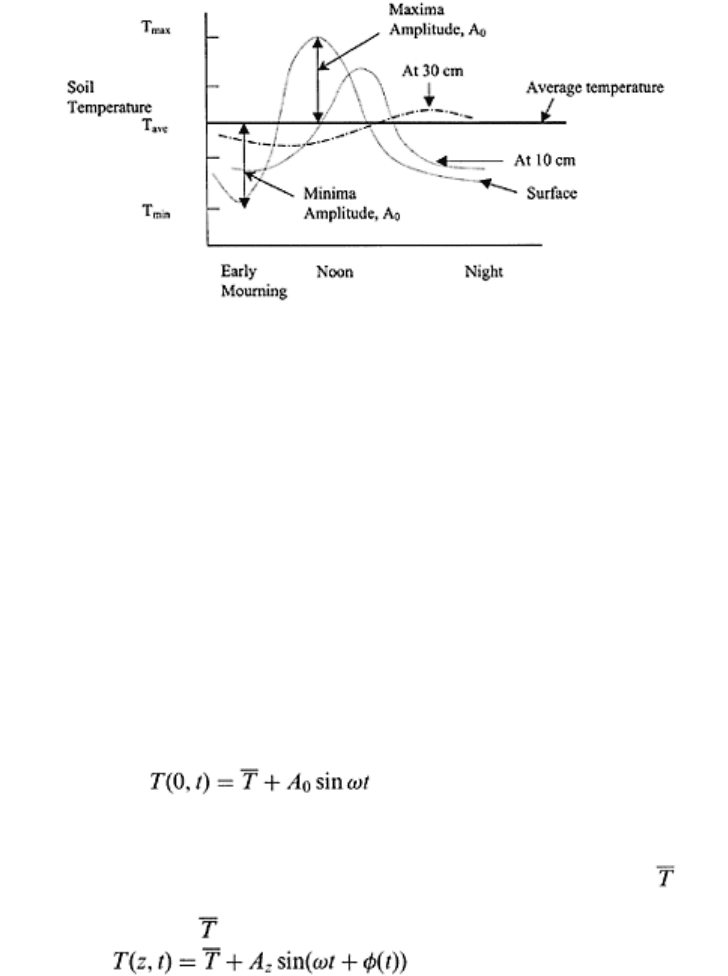
FIGURE 17.5 Schematic of diurnal
variations in temperature measured at
different depths.
17.8.2 The Annual Cycle
The annual variations in soil temperature result from the variations in short-wave
radiation throughout the year. As one goes farther away from the equator, the annual
variations in soil temperatures become significant. The summer months in June and July
in the Northern Hemisphere represent the peak of global radiations and temperatures,
whereas winter months have effects similar to nocturnal daily temperatures. During
summer months, the soil temperature at surface is less than that of deeper layers (Fig.
17.6) (Smith, 1932).
The diurnal and seasonal variations of heat can be mathematically represented by
assuming that soil temperature oscillates as a pure harmonic (sinusoidal) function of time
around an average temperature. Let us also assume that average temperature of soil for all
depths is the same. Assuming starting temperature as 0°C, the temperature at the soil
surface and at any time t [T(0, t)] can be expressed as
(17.11)
where A
0
is the amplitude of surface temperature fluctuation, to is the angular or radial
frequency (1 radian=57.3 degrees), which is 2π times the actual frequency, is the
average temparture and f is time. Assuming that at infinite depth (z=∞), the temperature
is constant and equal to (Fig. 17.5). Therefore, temperature at any depth [T(z, t)]
(17.12)
Principles of soil physics 488
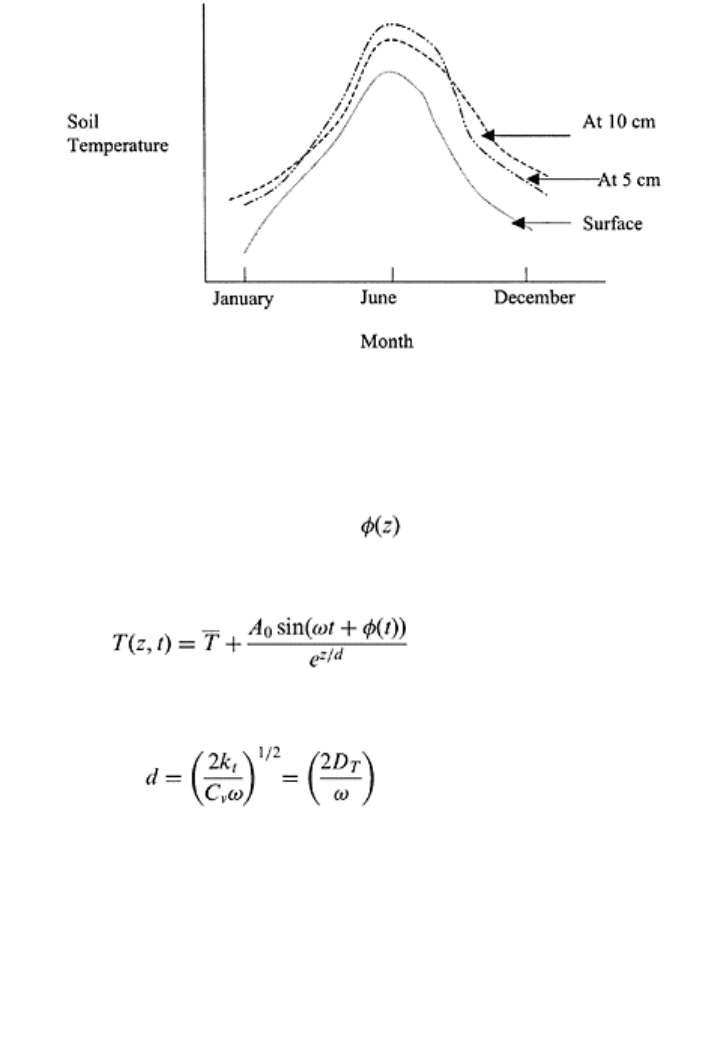
FIGURE 17.6 Schematic of annual
variations in temperature measured at
different depths in the Northern
Hemisphere.
where A
z
the amplitude at depth z and are the functions of z, but not time.
Incorporating the characteristic depth, also known as damping depth (d), which is defined
as the depth at which temperature amplitude decreases to the fraction 1/e* A
0
, or 1/2.718*
A
0
, or 0.37* A
0
, provides the following equation
(17.13)
The damping depth is also related to the thermal properties of the soil and the frequency
of temperature fluctuation by the following relationship
(17.14)
where C
v
is volumetric heat capacity and D
T
is thermal diffusivity of soil.
17.8.3 Soil Temperature Classes
Based upon the mean annual soil temperature, soil temperature regime is expressed in six
categories (SSSA, 1987) namely pergelic, cryic, frigid, mesic, thermic, and hyperthermic
(Table 17.4). In pergelic soils, mean annual temperature is lower, whereas in cryic soils,
it is higher than 0°C. If mean annual temperature is lower than 8°C, the soils are known
as frigid,
Soil temperature and heat flow in soil 489

TABLE 17.4 Classes of Soil Temperature
According to Taxonomy of Soils
Class Mean annual temperature Remarks
Pergelic <0°C Permafrost is present
Cryic 0°C< T<8°C Mean (T
summer
−T
winter
)=5°C at depth 0.5 m
Frigid <8°C Mean (T
summer
−T
winter
)>5°C at depth 0.5 m
Mesic 8°C<T<15°C Mean (T
summer
−T
winter
)>5°C at depth 0.5 m
Thermic 15°C<T<22°C Mean (T
summer
—T
winter
)>5°C at depth 0.5 m
Hyperthermic >22°C Mean (T
summer
−T
winter
)> 5°C at depth 0.5 m
Source: Modified from SSSA, 1987; Scott, 2000.
otherwise as mesic, provided mean annual temperature is below 15°C. For isofrigid,
isomesic, isothermic, and isohyperthermic soils, the temperature differs by less than 5°C.
17.9 HEAT TRANSFER IN SOIL
There are three principle heat transport processes: radiation, conduction, and convection.
17.9.1 Radiation
Radiation is the process of heat transfer in which the emission of energy is expressed in
the form of electromagnetic waves. The energy of the radiation field can also be
transmitted through a vacuum since it does not require a carrier. The energy travels as
discrete packets called quanta or photons, whose energy content depends on their
wavelength or frequencies. According to the Stefan–Boltzmann law, the total energy
emitted by a body, Ji, integrated over all wavelengths is proportional to the fourth power
of the absolute temperature of the body, T, and can be expressed as below:
J
t
=σAT
4
(17.15)
where A is the cross-sectional area of body (m
2
), and a is the Stefan– Boltzmann constant
and in SI units is expressed as 5.675×10−
8
Wm−
2
K
4
. Eq. (17.15) gives the maximum
energy flux that can leave a surface area A at any absolute temperature T. The ratio of
radiant energy emitted by soil and maximum amount of radiant energy emitted (ε
s
/ε
b
) is
known as emissivity coefficient, which equals one for a perfect emitter. Normally a
blackbody transmits the maximum and is known as a perfect emitter. Soils emit much
less radiant energy. The ε varies as a function of the wavelength of radiation and serves
as a correction factor or indicator of the efficiency of natural resources. Equation (17.15)
can be modified to Eq. (17.16):
Principles of soil physics 490

J
t
=εσAT
4
(17.16)
The T also determines the wavelength distribution of the emitted energy and is inversely
proportional to maximum radiation intensity, λ
m
, micrometers (µm), which is also known
as Wien’s law.
λ
m
=2900/T
(17.17)
Assuming the temperature of the soil as 300 K, the radiations emitted by soil surface [Eq.
(17.15)] have peak intensity at about 10 µm [refer to Eq. (17.17)] and its wavelength
distribution is over the range of 3–50 µ m, which falls in the infrared region. The Sun is a
blackbody and has a temperature of 6000 K. The radiation emitted by the Sun has a peak
intensity of about 500 nm [2900/6000]. The Sun’s radiation includes a visible light range
from 400 to 700 nm [400–425—Violet; 425–490—blue; 490–575—green; 575–585—
yellow; 585–650—orange; 650–700—red; and invisible light range from 100–400—
ultraviolet and 700–1400 nm—infrared (WHO, 1979), where 1nm=10
−9
m]. Planck’s law
describes the actual intensity distribution as a function of the wavelength, λ, and
temperature T as follows:
(17.18)
where E
λ
is the energy emitted for a given wavelength or range and C
1
and C
2
are
constants. In general, the incoming solar radiations are referred to as short-wave
radiations and the spectrum emitted by Earth comprises long-wave radiation. Most of the
solar radiation reaching Earth’s atmosphere is dissipated before it strikes the soil surface.
The dissipation occurs partially as a result of the reflection of radiation by clouds,
absorption by water vapor, oxygen, carbon dioxide*, and ozone, and diffusion by
molecules and particles in air. Solar radiation reaching Earth’s
* Greenhouse gases allow incoming solar radiation to pass through Earth’s atmosphere, but prevent
most of the outgoing infrared radiation from the surface and lower atmosphere from escaping into
outer space. The greenhouse effect is the rise in temperature that Earth experiences because certain
gases in the atmosphere (water vapor, carbon dioxide, nitrous oxide, methane, halogenated
fluorocarbons, ozone, perfluorinated carbons, and hydrofluorocarbons) trap energy from the Sun.
Without these gases, heat would escape back into space and Earth’s average temperature would be
about 33°C colder. Because of how they warm Earth, these gases are referred to as greenhouse
gases (http://www.epa.gov/globalwarming).
surface is partly direct and partly in the form of scattered beams. After striking the crop
or canopy, a fraction of incoming radiation is reflected back to the atmosphere, which is
known as albedo (α). The thermal radiations are also transmitted from soil surface into
the atmosphere Dearth, and onto soil surface from clouds Rsky, therefore net radiation
(R
N
) is:
R
N
=(1−a)R
s
+R
nt
(17.19)
Soil temperature and heat flow in soil 491

where R
s
is global solar radiation (sum of direct and scattered beam) and R
nt
is net long-
wave thermal radiation (R
sky
−R
earth
). The R
N
varies significantly with climate, latitude,
and surface cover. For a known value of emissivity, both R
sky
and Dearth can be
calculated by the Stefan–Bolzmann equation (17.15).
17.9.2 Conduction
Conduction is the primary heat transfer mechanism in soil and refers to the propagation
of heat within a soil or another body by molecular motion. It is the transfer of
translational, rotational, and vibrational energy from molecule to molecule. The process
of heat conduction is analogous to diffusion and both try to equilibrate, or even out,
mixer’s distribution of molecular kinetic energy. The heat flow by conduction in soil
takes place from warmer locations towards the cooler regions. Fourier law explains the
heat flow by conduction and macroscopically one-dimensional conduction of heat energy
through a soil section is described as follows
(17.20)
where q
h
is the heat flux (Js
−1
), k
T
is proportionality constant or thermal conductivity
(Jm
−1
s
−1
K
−1
), A is the area of cross section (m
2
), T is the temperature in °K, and ∂T/∂z is
the temperature gradient in degrees per unit length and the slope of the temperature-
distance curve. The negative sign in Eq. (17.20) indicates that heat transfer occurs in the
direction of decreasing temperature. Thermal conductivity of solids (Table 17.5) varies
from 1 J m
−1
s
−1
K
−1
to 100 J m
−1
s
−1
K
−1
. For liquids and gases, it ranges from
0.01Jm
−1
s
−1
K
−1
to 1.0Jm
−1
s
−1
K
−1
and 0.001 J m
−1
s
−1
K
−1
to 0.1 J m
−1
s
−1
K
−1
, respectively.
The ratio of q
h
and A is also known as heat flux density (Jm
−2
s
−1
).
17.9.3 Convection
The transfer of heat energy in a convection process involves the movement of a heat-
carrying mass. Infiltration of warm water into an initially cold soil
TABLE 17.5 Thermal Conductivity of Certain
Metals (at 25°C)
Metal Thermal conductivity (cal cm
−1
s
−1
°C
−1
)
Aluminium 9.56
Copper 16.25
Gold 2.44
Iron 2.24
Platinum 0.75
Silver 7.05
Principles of soil physics 492

Tungstun 4.88
Source: Adapted from Handbook of Chemistry and Physics, 1988–89.
results in heat transfer by the process of convection. Newton’s first law of cooling can be
used to calculate energy fluxes in and out of the system
q
v
=C
v
Av(T
s
−T
0
) or L*E
(17.21)
where q
v
is the heat flux of convection (Js
−1
or W), C
v
is the volumetric heat capacity
(Jm
−3
K
−1
), v is the velocity of fluid (m s
−1
), T
s
is the temperature of the soil in contact
with fluid (K), T
0
is the temperature of the fluid far away from the surface (K), L is latent
heat of vaporization, and E is evaporation rate. The convection phenomenon is probably
more important in the atmosphere, where there is a consistent circulation of warm and
cold air and heat exchange. In soils, the heat convection phenomenon is less important in
general, however, during infiltration and redistribution of water in the soil profile, which
is cooler than the incoming water, convectional heat energy transport becomes important.
17.10 OTHER PROCESSES OF HEAT EVOLUTION AND
TEMPERATURE IN SOIL
17.10.1 Condensation
The conversion of water vapor to a liquid state is known as condensation. Condensation
is an exothermic process, and the heat energy released in condensation warms the soil
surface. A similar phenomenon is observed when liquid water freezes. About 600 cal g
−1
of heat energy is released when water vapor condenses, whereas 80 cal g
−1
of heat (of
fusion) is taken up when soil freezes. The six-phase changes that water can undergo and
the heat gained and lost is given in Table 17.6.
TABLE 17.6 The Six Phase Changes That Water
Can Undergo and the Heat Gained and Lost
Process From To Heat gained/lost (calg
−1
)
Condensation Vapor Liquid 600
Evaporation Liquid Vapor −600
Freezing Liquid Ice 80
Melting Ice Liquid −80
Deposition Vapor Ice 680
Sublimation Ice Vapor −680
Source: Modified from http://www.usatoday.com/weather/wlatentl.htm.
Soil temperature and heat flow in soil 493
